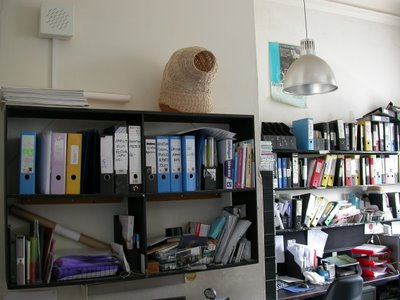Wicker Head Cover
 Artist: Isolda Pujol Piza
Artist: Isolda Pujol Piza Location: Exhibitions Office
Medium: Cain, Wicker
Comment: I have used basket making techniques in a new context inspired by Pieter Bruegel's Painting “The Beekeeper”. The drawing that shows the dress worn by beekeepers in the past, identifies a way they protected their faces from the bee stings. The dress consisted in a head cover made of weaved cane and it has a round flat surface. The hood is sewed to the piece completing the head’s protection. I designed a head cover or face using traditional basket making and weaving techniques. My research was also based on the contemporary and historical issues surrounding the dress worn by Muslim women, which covers them from head to foot. In contrast between the beekeepers and the muslim head-cover, I have to say beekeepers protect themselves in a physical way to protect them from the bee sting. The physical qualities beekeepers want to protect by the actions they are undertaking, are connected by their bodies rather than their mind. Beekeepers perform an individualistic activity to a certain extent. On the other hand, Muslim women cover themselves in the public domain, where they can go about freely and where they can easily be seen heard. I wanted to explore the spiritual belief Muslim women have, which tells them, not to display their beauty and ornaments in the public, and advise them as well to dress in a modest fashion. I assume that the public spirited attitude Muslim women have help underline the community they belong to.

0 Comments:
Post a Comment
<< Home